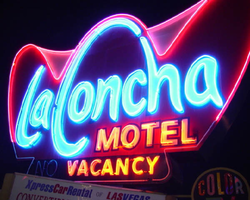Search the Special Collections and Archives Portal
Search Results
James Cashman Sr. Papers
Identifier
Abstract
The James Cashman Sr. Papers date from approximately 1890 to 1969 and contain correspondence, photographs, insurance records, and bank records related to Cashman and his businesses in Southern Nevada. The collection documents the lives of the Cashman family and their businesses in southern Nevada.
Archival Collection
Bill Campbell Costume Designs
Identifier
Abstract
The Bill Campbell Costume Designs (1954-1978) are comprised of original costume design sketches created by designer Bill Campbell for a number of Donn Arden's stage productions, including Pzazz!, Hello America, and Hello Hollywood Hello that were staged in the Crystal Room at the Desert Inn in Las Vegas, Nevada during the 1960s and 1970s. The collection also contains some sketches for other revues held in Los Angeles, California and Reno, Nevada. The majority of items in the collection are original drawings with attached fabric swatches; a number of items are xeroxed reproductions.
Archival Collection
Sondra Cosgrove (Vote Nevada) oral history interview conducted by Magalena Martinez and Elia Del Carmen Solano-Patricio: transcript
Date
Archival Collection
Description
From the Lincy Institute "Perspectives from the COVID-19 Pandemic" Oral History Project (MS-01178) -- Community organization interviews file.
Text

Tony F. Sanchez III oral history interview: transcript
Date
Archival Collection
Description
Oral history interview with Tony F. Sanchez III conducted by Barbara Tabach and Claytee D. White on August 31, 2018 for the Latinx Voices of Southern Nevada Oral History Project. In this interview, Sanchez describes his role as the Senior Vice President of NV Energy, and his past experience working for Senator Richard Bryan. He discusses his educational background as a University of Nevada, Las Vegas (UNLV) graduate and attending Arizona State University Law School. Sanchez also describes his role as a past president of Latin Chamber of Commerce in Las Vegas, Nevada.
Text

James Matson interview, February 23, 1980: transcript
Date
Archival Collection
Description
On February 23, 1980, Ken Rose interviewed James Matson (b. July 14, 1923 in Pensacola, Florida) about his life in Las Vegas, Nevada. Throughout the interview, Matson discusses his childhood, life in Florida before moving to Las Vegas, his family and what brought him to Las Vegas. Matson also delves into his economic struggles and those of the community, his attempt to purchase a home and the changes he would like to see in society. Moreover, Matson talks about his hobbies, his work in construction and interracial friendships. The interview ends with Matson discussing the city of Las Vegas, the weather and the changing buildings.
Text

Photographs of La Concha sign, Las Vegas (Nev.), 2002
Date
Archival Collection
Description
Site address: 2955 S Las Vegas Blvd
Sign owner: Edward Doumani
Sign details: The La Concha is located north of the Riviera hotel Casino, just past the giant glass wall advertising for Splash. The La Concha double sided ground sign, sits close to the street on the east side of the strip, facing north /south. Directly to the east the origin of the signs shape resides in the form of the front structure of the La Concha's lobby structure. The sweeping elliptical roofline creates a structure dripping with the flavor of outlandish 50's-60's expressionistic modern design. The roadside ground sign reflects this shape actually mimicking it in a stylized silhouette of itself. The two icons are separated by a small but busy parking lot that expands north of the La Concha to house other similar style structures. The wings of the hotel, which extend out behind the main lobby, are a rather stark and plainly rectangular form, compared to the front portion of the lot.
Sign condition: Structure 4 Surface 4 Lighting 4 Notes: Considering the age of the property and the sign, it is in great condition, everything is intact, but not perfect.
Sign form: Pylon
Sign-specific description: The sign resides in a pleasant spot of green grass, among the concrete and black top surfaces. A rectangular base, painted a light hue of blue and gold, supports a double-sided sculpted cabinet in a three-pointed crown, which is the stylized profile of the building in sits in front of. Below the main cabinet a triangular internally lit message center has been added, as well as two more, flat rectangular cabinets on the north and south sides. The cabinets are adorned with text that advertising for car rentals located in the same neighboring lot. Off of the west side of the cabinet a small circular cabinet is cantilevered off of the edge. It is an internally lit marker, noting that color television is available inside. The surface of the actual cabinet is painted red, and is somewhat faded. The section of the cabinet that would be dedicated to the low-lying portions of the La Concha's roof are addressed in white. The "La Concha" is spelled across the front of the sign in white text outlined in blue. The text is designed specific to the sign, for the capital L and C are shaped to match the contours of the crowns of the sign. The rest of the script also takes on some of the same stroke of the manner. Motel is spelled in the same coloring across the bottom right hand portion of the signs face, in block text. The very bottom portion of the cabinet is a black painted horizontal extension with edges that angle back into the body of the sign. The words "vacancy' are written across the surface of the sign to the right hand side. No is spelled on the left, but only in neon. When illuminated the main text is lined with a light electric blue, while the edges, and the top contours are lined with a pink and fuchsia glowing borders. The words "vacancy" and "motel" are lined in an orange, amber colored, warm tubing.
Sign - type of display: Neon; Incandescent; Backlit
Sign - media: Steel; Plastic
Sign - non-neon treatments: Graphics; Paint
Sign animation: none
Sign environment: The La Concha sits just to the south of the Riviera's giant glass wall. Headed south, the property comes into view, being a quiet transition from the extreme nature of the Riviera. The sign sits in a black top expanse that meanders back into the rest of La Concha's property. The base of the sign is surrounded with plants and curbing, firmly rooted into the urban mainstream of the neighboring street.
Sign manufacturer: YESCO
Sign - thematic influences: The theme of the La Concha can be drawn directly from 1950's and 60's modern design. Such curve can be seen signs of the decade for example the original Dunes pylon displays elements of such curve and swell. In Jorg Rugemer's Lost Las Vegas, there is a picture of a 60's era automobile sitting next to the building. It is used to show the influences of the structures design present in the design of something as common as the automobile. It is reminiscent of the protruding fins and large eye like taillights seen on such autos. The sign itself is an interpretation of the building in a silhouette form, so it's angle draw from the same pool as well. The coloration of the neon is also reminiscent of the era. The turquoise, vermilion and red are reminders of such properties as the original Flamingo, and the Algiers.
Surveyor: Joshua Cannaday
Survey - date completed: 2002
Sign keywords: Pylon; Neon; Incandescent; Backlit; Steel; Plastic; Graphics; Paint
Mixed Content
Maurine and Fred Wilson and Dr. William S. Park Photograph Albums
Identifier
Abstract
The Maurine and Fred Wilson and Dr. William S. Park Photograph Albums (1900-1930s) consist of twelve albums containing black-and-white photographic prints and three black-and-white photographic negatives. The photographs are primarily related to the families of William S. Park, John S. Park, and Fred and Maurine Hubbard Wilson. Included are images of the Park homes in Las Vegas, Nevada; Park and Wilson family members; scenes of early Las Vegas, Nevada; outdoor activities, and vacation trips to California, Colorado, and Mexico.
Archival Collection
Fred and Maurine Wilson Photograph Collection
Identifier
Abstract
The Fred and Maurine Wilson Photograph Collection depicts the Wilson Family, events, and locations in Las Vegas, Nevada and the Southwestern United States from approximately 1860 to 1990. The photographs primarily depict early Las Vegas, including the Mormon Fort and Kiel Ranch; mines, towns, and railroads in Southern Nevada; the construction and planning of the Hoover (Boulder) Dam on the Colorado River; and the Wilson Family. The photographs also include prominent Las Vegas families such as the Park Family, aerial photographs of the city, landmarks on Fremont Street and downtown Las Vegas, and desert landscapes.
Archival Collection
Maurine and Fred Wilson Papers
Identifier
Abstract
The Maurine and Fred Wilson Papers (1888-1991) contain family papers and the historical research of Fred Wilson. It includes correspondence between Maurine and Fred Wilson, as well as Maurine Wilson’s diaries, calendars, and materials related to her career as a music teacher. The collection also contains Fred Wilson’s research files about the history of Southern Nevada as well as the First Methodist Church in Las Vegas, Nevada.
Archival Collection

Bobbie and Cody Lin Jones oral history interview: transcript
Date
Archival Collection
Description
Oral history interview with Bobbie and Cody Lin Jones conducted by Claytee D. White on December 9, 2017 for the Remembering 1 October Oral History Project. In this interview, Bobbie and Cody Lin Jones, mother and daughter, discuss their love for country music and their experience going to the Route 91 Harvest music festival in 2017. Bobbie describes how her military training helped her and her daughter survive the shooting of that weekend, and both discuss what they had seen during the shooting. Bobbie and Cody Lin talk about adjusting to life after the event and the little things that have changed in their day-to-day living.
Text
